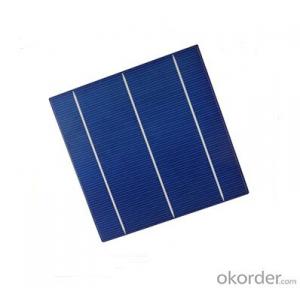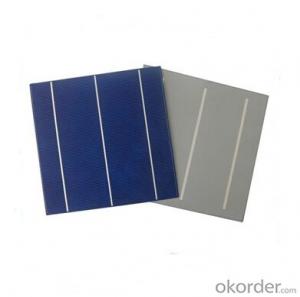Custom Polycrystalline Solar Cells Series- 17.8%156mm×156mm±0.5mm
- Loading Port:
- Shanghai
- Payment Terms:
- TT OR LC
- Min Order Qty:
- 3000 pc
- Supply Capability:
- 1000000 pc/month
OKorder Service Pledge
OKorder Financial Service
You Might Also Like
Solar Cells:
Solar cells is made by solar wafer, it has three categories of solar cell right now, monocrystalline polycrystalline and thin film,These cells are entirely based around the concept PN junction, which is the critical part of solar module, it is the part that can convert the light energy into electricity, the thickness is from 180um to 200um, with even busbars to conduct electricity, textured cell can decrease diffuse reflection; they are often electrically connected and encapsulated as a module. Photovoltaic modules often have a sheet of glass on the front (sun up) side, allowing light to pass while protecting semiconductor wafers from abrasion and impact due to wind-driven debris, rain, hail, etc. Solar cells are also usually connected in series in modules, creating an additive voltage. Connecting cells in parallel will yield a higher current;With high quality and stable quality. Our Cells can greatly improve the performance of Solar Modules.
Features:
1. High conversion efficiencies resulting in superior power output performance.
2. Outstanding power output even in low light or high temperature conditions
3. Optimized design for ease of soldering and lamination
4. Long-term stability, reliability and performance
5. Low breakage rate
6. Color uniformity
Solar Cells Advantage:
1. Tire-1 Solar Cells’ Manufacturer Quality Guarantee. With a complete and sophisticated quality government system, our Quality Management have arrived world’s leading place. Customer can receive Tire-1 Cells Maker’s Quality Standard Products.
2. Trusted Warranty. We can supply trusted after-sales service to our customer. If our cells are found not in conformity to the specification of manufacturer, or should the inspected quantity found in shortage, or should the packing found damaged, the buyer has the right to claim to the seller. The claim, if any, should be presented to seller within 30 days after cargo's arrival date to the port, together with related inspection report and photos issued and provided by a reputable independent surveyor such as SGS.
3. World’s Leading Manufacturer Equipment. We imported the newest and leading production equipment from abroad. Advanced equipment can guarantee the stable quality of cells. Auto production line can also save labor cost which will further cut our production cost.
4. Bulk supply: With the production capacity of 500MW, we can produce large quantity every month. This can satisfy most customer requirement.
Specifications:
1.Size:156x1156±0.5mm thickness:200±20μm
2.Covered with derk blue silicon nitride antireflection coating;3 busbars of 1.5mm width and 80 fingers
3.Covered with aluminun BSF;15 welded substrate(silver)of 9x3mm size.
Format | 156mm×156mm±0.5mm |
Thickness | 210μm±30μm |
Front(-) | 1.4mm bus bars(silver), blue anti-reeecting coating(silicon nitride) |
Back(+) | 2.0mm wide soldering pads(silver) back surface eld(aluminum) |
Efficiency(%) | Pmpp (W) | Umpp(V) | Impp(A) | Uoc(V) | Isc(A) | FF(%) |
17.80-18.00 | 4.33 | 0.53 | 8.159 | 0.633 | 8.709 | 78.44 |
17.60-17.80 | 4.29 | 0.527 | 8.126 | 0.631 | 8.677 | 78.27 |
17.40-17.60 | 4.24 | 0.524 | 8.081 | 0.628 | 8.629 | 78.17 |
17.20-17.40 | 4.19 | 0.521 | 8.035 | 0.625 | 8.578 | 78.08 |
17.00-17.20 | 4.14 | 0.518 | 7.99 | 0.623 | 8.531 | 77.97 |
16.80-17.00 | 4.09 | 0.516 | 7.938 | 0.62 | 8.478 | 77.85 |
16.60-16.80 | 4.04 | 0.514 | 7.876 | 0.618 | 8.419 | 77.68 |
16.40-16.60 | 3.99 | 0.511 | 7.813 | 0.617 | 8.356 | 77.51 |
16.20-16.40 | 3.94 | 0.509 | 7.754 | 0.615 | 8.289 | 77.4 |
16.00-16.20 | 3.9 | 0.506 | 7.698 | 0.613 | 8.22 | 77.36 |

FAQ
We have organized several common questions for our clients,may help you sincerely:
①What price for each watt?
It depends on the efficiency of the solar cell, quantity, delivery date and payment terms.
②How long can we receive the product after purchase?
In the purchase of product within three working days, We will arrange the factory delivery as soon as possible. The pecific time of receiving is related to the state and position of customers.Commonly 7 to 10 working days can be served.
③Can you provide the peripheral products of the solar panels, such as the battery, controller, and inverter? If so, can you tell me how do they match each other?
Yes, we can, we have two companies for solar region, one is CNBM International, the other is CNBM engineering Co.
We can provide you not only the solar module but also the off grid solar system, we can also provide you service with on grid plant.
④What is your warranty of solar cell?
Our product can promise lower than 0.3% open box crack, we support claim after opening the box if it has crackm color difference or sth, the buyer should give pictures immediately, we can not accept the claim after the solar cell has assembled to solar panel.
• Timeliness of delivery
• ⑤How do you pack your products?
We have rich experience on how to pack the solar cell to make sure the safety on shipment, we could use wooden box or pallet as buyer's preference.
- Q: How do solar cells perform in high altitude environments?
- Solar cells perform well in high altitude environments due to several factors. Firstly, at higher altitudes, there is less atmospheric interference, which means that solar cells receive more direct sunlight and can generate more electricity. Additionally, the colder temperatures at high altitudes can improve the efficiency of solar cells, as they operate more efficiently at lower temperatures. Furthermore, in regions with high altitude, there is often less cloud cover and air pollution, allowing solar cells to receive even more sunlight and operate at maximum capacity. Overall, solar cells are highly suitable for high altitude environments and can provide efficient and reliable renewable energy generation.
- Q: Can solar cells be used in aircraft applications?
- Yes, solar cells can be used in aircraft applications. They can be integrated into the structure of an aircraft to generate electricity from sunlight, which can power various onboard systems such as lighting, communication equipment, and navigation instruments. Additionally, solar cells can also be used to charge batteries in electric aircraft or unmanned aerial vehicles (UAVs), extending their flight time and reducing reliance on traditional fuel sources.
- Q: Can solar cells be used in boats or marine applications?
- Yes, solar cells can be used in boats or marine applications. Solar panels can be installed on the deck or roof of a boat to harness the power of the sun and convert it into electricity. This electricity can then be used to power various onboard systems such as lights, navigation equipment, communication devices, and even recharge batteries. Solar power offers a sustainable and environmentally-friendly energy solution for boats, reducing reliance on traditional fuel sources and minimizing the carbon footprint of marine activities.
- Q: What is the role of maximum power point tracking in solar cell systems?
- The role of maximum power point tracking (MPPT) in solar cell systems is to ensure that the solar panels operate at their most efficient point of power generation. MPPT algorithms continuously adjust the operating voltage and current of the solar panels to track the maximum power point, which is the point where the panels produce the maximum power output for a given set of environmental conditions. By optimizing the power output, MPPT increases the overall efficiency and performance of the solar cell system, maximizing the energy harvest from the sun.
- Q: Can solar cells be used to power remote locations?
- Yes, solar cells can be used to power remote locations. Solar cells, also known as photovoltaic cells, convert sunlight into electricity. They can be installed in remote areas where there is no access to the grid or where it is not feasible to connect to the grid. Solar power is a sustainable and renewable energy source, making it an ideal solution for powering remote locations that are off the grid.
- Q: How does the size of a solar cell affect its performance?
- The size of a solar cell directly affects its performance. Generally, larger solar cells can generate more electricity as they have a larger surface area to collect sunlight. This means they can absorb more photons and convert them into electrical energy. Additionally, larger solar cells tend to have lower resistance and better efficiency. However, larger cells also require more materials and are more expensive to produce. Therefore, the optimal size of a solar cell depends on various factors, including the available space, budget, and desired energy output.
- Q: Can solar cells be used in remote sensing applications?
- Yes, solar cells can be used in remote sensing applications. Solar cells can generate electricity from sunlight, which can be used to power sensors, data loggers, and communication devices in remote sensing systems. This allows for continuous and self-sustained operation of these systems in remote and inaccessible areas where traditional power sources are unavailable.
- Q: How do solar cells handle fluctuating sunlight intensity?
- Solar cells are designed to handle fluctuating sunlight intensity by having built-in mechanisms that regulate the amount of energy they produce. These mechanisms include maximum power point tracking (MPPT) algorithms, which continuously monitor the incoming sunlight and adjust the voltage and current output of the solar cells to maximize their efficiency. Additionally, solar cells are also equipped with bypass diodes that help in bypassing shaded or underperforming cells, ensuring that the overall system performance is not significantly affected by fluctuating sunlight intensity.
- Q: What's the benefit of using a solar cell?
- It can help avoid the greenhouse effect.
- Q: Can solar cells be used in aviation or aerospace applications?
- Yes, solar cells can be used in aviation or aerospace applications. They are commonly used to power satellites, space probes, and unmanned aerial vehicles (UAVs) due to their ability to convert sunlight into electricity. Solar cells can provide a reliable and sustainable source of power in remote and high-altitude environments.
Send your message to us
Custom Polycrystalline Solar Cells Series- 17.8%156mm×156mm±0.5mm
- Loading Port:
- Shanghai
- Payment Terms:
- TT OR LC
- Min Order Qty:
- 3000 pc
- Supply Capability:
- 1000000 pc/month
OKorder Service Pledge
OKorder Financial Service
Similar products
Hot products
Hot Searches
Related keywords


























